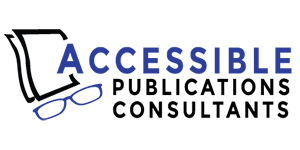Is Your Agency Vision Friendly
Senior Savvy
By Robert Goodman, MSW
This may sound like a strange question to ask agencies that serve people with visual disabilities, but my experiences indicate that even agencies serving the blind and visually impaired need to learn how the Americans with Disabilities Act and the Rehabilitation Act of 1973 affect their services.
In July we celebrate the 30th anniversary of the Americans with Disabilities Act requires that any printed materials shared with clients of government agencies or social service agencies must be available in alternate format such as braille, large print, or audio. The Rehabilitation Act has the same requirement if you receive federal funds.
This also applies to websites and other means of communicating with clients. For example, the use of PDFs.
Assistive technology software cannot read or extract the words in a scanned, or graphical representation, of a text. Furthermore, users cannot select or edit the text or manipulate the PDF for accessibility. Scanned images of text must be converted into to searchable text using optical character recognition (OCR) before addressing accessibility in the document.
Many client contacts today are done via zoom. It is difficult for many of us to learn long passwords to get into a zoom meeting. The best method is to establish a waiting room and have the client wait to be invited into the meeting. If you need to use a password, make it short and simple.
If agencies for the blind and visually impaired don’t comply with the law how can we expect the business world to comply?
Many people with visual impairments are not aware of their rights under the ADA or Rehab Act. We need to educate our clients about this aspect of the law. Most people with visual impairments, particularly the elderly, are not aware of their rights to request written materials in alternate formats. We must educate the visually impaired community about their rights.
To be considered a vision friendly agency you must:
Provide documents and publications in large print, braille, or audio. Large print is considered to be 18 point with a non-seraph typeface such as Arial. An agency or organization may have a large print version available, which would meet the ADA expectations, but that doesn’t mean that the consumer will be able to see it, depending on the degree of vision loss. It can be appropriate to use different typefaces for some applications, like an Excel spreadsheet, posters or displays. Very thin, light, or bizarre typefaces make legibility difficult for people with vision impairment.
Be willing to assist consumers in filling out applications or other forms
Be willing to read any documents to persons with visual impairments.
Have an accessible website
Have these policies in writing.
Celebrate the anniversary of the Americans with Disabilities Act by being vision friendly.
For help with ADA compliance or for staff training please contact Robert Goodman, MSW at rgoodlobby@aol.com or 954-806-7321. Visit my website at www.flnavigator.com.


